Don't let food poisoning ruin your holidays
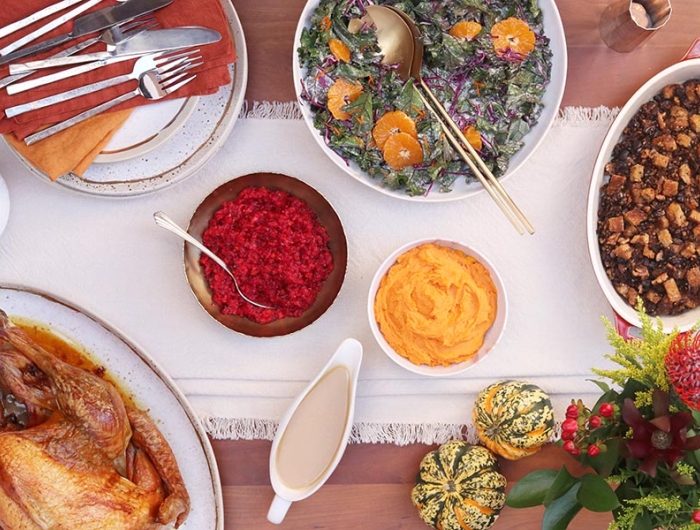
How you handle food matters—whether it’s meat, poultry, fruits, vegetables, baked goods, or leftovers.
The harmful bugs that cause food poisoning can show up in any of those foods. Here’s how to lower your risk.
Cider, eggnog, and other seasonal treats
Cider. Avoid unpasteurized cider, especially for older adults, children, or those with weakened immune systems. Or mull the cider: heat it on the stovetop (to boiling) and add spices.
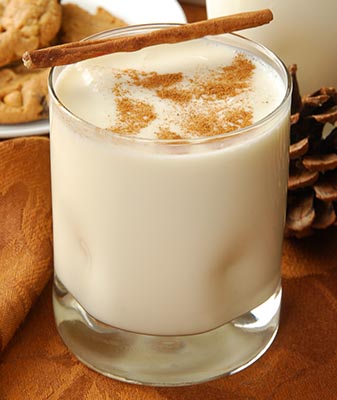
Eggnog. Homemade eggnog could be contaminated with bacteria in raw eggs. It’s safer to use pasteurized eggs or buy ready-made eggnog, which is pasteurized. (Look for low-fat, soy, or almond milk nogs.) Make your own safely by gradually heating the egg-milk mixture to 160˚F or until it coats a metal spoon.
Cookie dough. Raw eggs aren't the only food safety risk from raw cookie dough. Flour can be contaminated when the grain is still in the field or at other steps during production. And raw flour isn't treated to kill germs (until you cook it).
For example, in one 2016 outbreak, 56 people—aged 1 to 95—were diagnosed with Shiga toxin-producing E. coli infections, which can cause bloody diarrhea and may lead to kidney failure. A quarter of them had to be hospitalized. The culprit: contaminated flour that the people tasted as unbaked homemade dough or batter. Three children got sick after restaurant staff gave them raw dough to play with while waiting for their meals.
To avoid E. coli in raw flour (or Salmonella in raw eggs), don’t taste unbaked dough or batter and wash your hands after handling raw flour or eggs.
More holiday foods. To see tips for turkey, pie, pâté, icing, and other holiday foods, check out our article 6 food safety bloopers to avoid this holiday season.
Vegetables and fruits
Keep these tips for buying and washing produce in mind:
- Buy fresh-cut produce like bagged salad greens or half a melon only if it is refrigerated or surrounded by ice.
- Separate raw meat, poultry, and seafood from fruits, vegetables, and other foods in your shopping cart and in your refrigerator.
- Wash your hands for 20 seconds with warm water and soap before and after preparing any food.
- Wash fruits and vegetables under running water just before eating, cutting, or cooking, even if you plan to peel them. Don’t use soap (it leaves a residue). Produce washes are okay, but not necessary.
- Scrub firm produce like cucumbers with a clean produce brush. Let them air dry before cutting.
- Don’t rinse bagged, pre-washed salad greens. You’re more likely to contaminate them with bugs from your sink than to make them safer to eat.
- Discard the outer leaves of heads of leafy vegetables like cabbage and lettuce.
Leftovers
Leaving cooked food at room temperature is an invitation for bacteria that can cause food poisoning—like Clostridium perfringens and Staphylococcus aureus—to multiply. (And reheating the leftovers won’t destroy their toxins or spores.)
So refrigerate or freeze leftovers promptly. Meat and all perishable foods should be left out for no more than 2 hours.
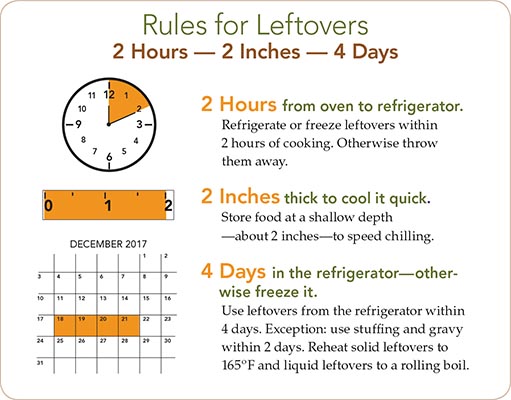
Meat and poultry
Make sure to use a food thermometer. Cook steaks, roasts, and chops to 145˚F, then let them rest for at least three minutes. Poultry—turkey, chicken, or duck—needs to reach 165˚F.
Fish is done (145˚F) when its flesh is opaque and separates easily with a fork.
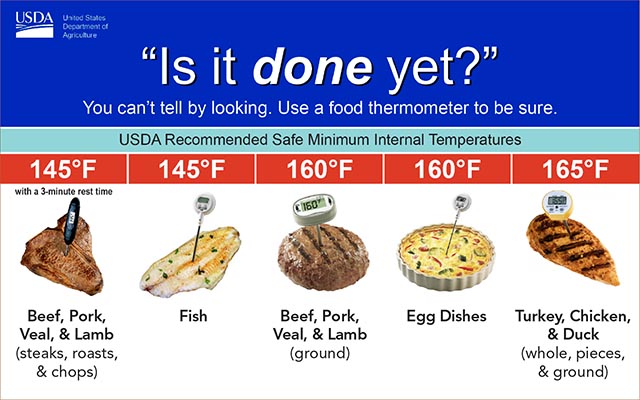
Tips for turkey
If you're serving turkey this year, we have shopping tips and advice to safely prepare and cook yours.
Shopping for a turkey?
Here's what to expect from some common labels on poultry and meat:
Natural: “Natural” meat and poultry contains no artificial ingredients or added colors and is no more than “minimally processed.” But “natural” tells you nothing about how an animal was raised, what it was fed, or whether it got antibiotics or hormones.
- Organic: No growth hormones or antibiotics, fed organic feed with no animal byproducts, and animals have some outdoor access.
- No added antibiotics: The animal was raised without antibiotics. (Sick animals that need antibiotics are treated, but their meat cannot carry a “no antibiotics” or “organic” claim.)
- No added hormones: The claim is meaningless for chickens or turkeys, since farmers are prohibited from giving those animals hormones. For cows or pigs, the claim means that they were not given hormones.
- Free range: Hens weren't confined in cages and they have some access to the outdoors. (The outdoor area may be covered with netting.)
(The USDA doesn't precisely define some of these claims, but most labels have to explain them, and the USDA must approve meat and poultry labels.)
Buying frozen? How to properly thaw:
Turkey, or any other meat, should never be defrosted on the counter. The safest way to thaw your turkey is in the refrigerator, so plan ahead: Turkeys need approximately 24 hours for each 4 to 5 pounds of weight. Put the bird on a plate, to catch any liquid as it thaws.
Once thawed, cook your bird within 1 to 2 days or refreeze.
Is it safer to rinse off the turkey before cooking?
Nope. Water can splash bacteria from the raw turkey onto countertops, other food, towels, and you. Transfer the turkey straight from package to pan. The heat from cooking will kill any bugs.
Cooking your turkey
A few tips:
- Only cook a turkey once it's completely thawed.
- Your oven temperature should never be lower than 325°F.
- Use a food thermometer (not just a pop-up thermometer on the turkey) in the innermost part of the thigh and wing, the thickest part of the breast, and in any stuffing. The thermometer should read at least 165°F.
Planning ahead? These are approximate cooking times for turkey, but use the thermometer to check when yours is done:

For a higher-quality roast, let the turkey stand for 20 minutes to allow the juices to set. The bird will also carve more easily.
Cooking stuffing safely
The safest way to cook stuffing is on the stove or in the oven—separate from the turkey.
If you cook the stuffing inside the bird, loosely stuff the turkey just before you put it in the oven, with three-quarters of a cup of stuffing per pound of turkey. Use a food thermometer to make sure the center of the stuffing reaches 165˚F.
Sources: N. Engl. J. Med. 377: 2036, 2017, Centers for Disease Control and Prevention, U.S. Department of Agriculture, U.S. Food and Drug Administration, CSPI, USDA’s Washing Food: Does it Promote Food Safety?; Turkey from Farm to Table.
Photos: © azurita/fotolia.com (cookie dough), © MSPhotographic/fotolia.com (eggnog), USDA (temperatures).
Topics
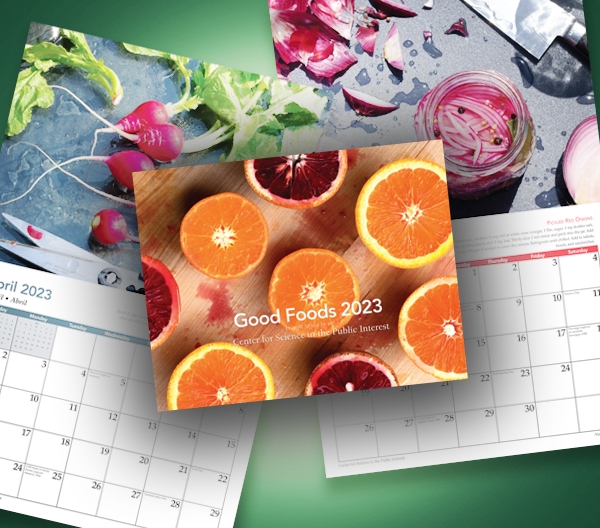
Calendar
Good Foods 2023
Every gorgeous photo in the Good Foods 2023 calendar will whet your appetite for delicious, healthy food. And the simple recipe below each photo, from Healthy Cook Kate Sherwood, will help you turn that month’s star into the star of your dinner table.

